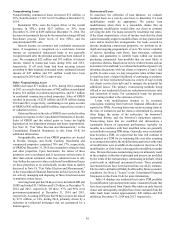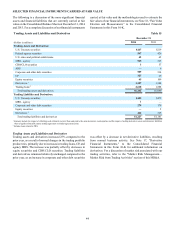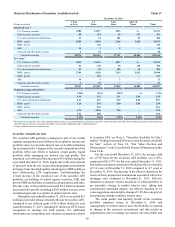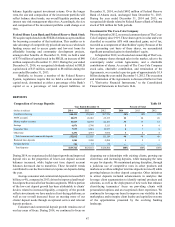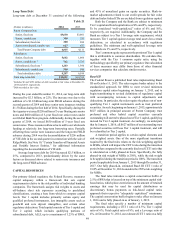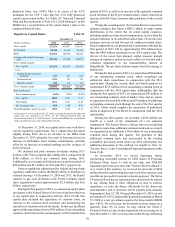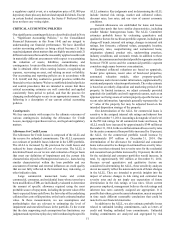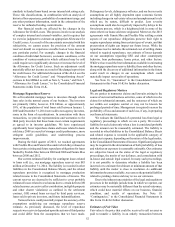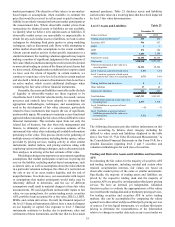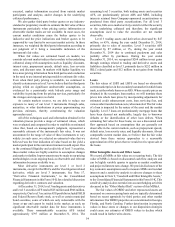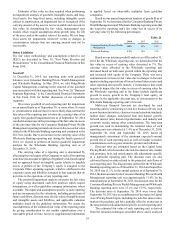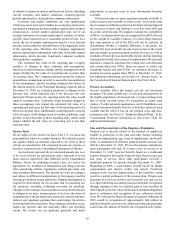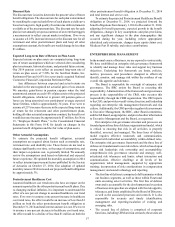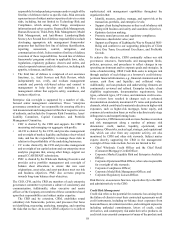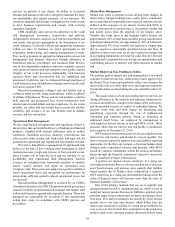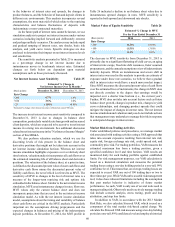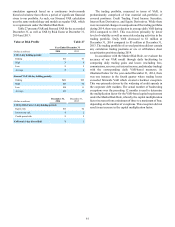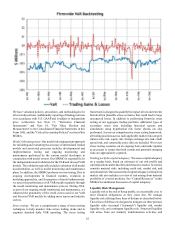SunTrust 2014 Annual Report Download - page 75
Download and view the complete annual report
Please find page 75 of the 2014 SunTrust annual report below. You can navigate through the pages in the report by either clicking on the pages listed below, or by using the keyword search tool below to find specific information within the annual report.52
similarly to funded loans based on our internal risk rating scale.
These risk classifications, in combination with an analysis of
historical loss experience, probability of commitment usage, and
any other pertinent information, result in the estimation of the
reserve for unfunded lending commitments.
Our financial results are affected by the changes in the
Allowance for Credit Losses. This process involves our analysis
of complex internal and external variables, and it requires that
we exercise judgment to estimate an appropriate Allowance for
Credit Losses. As a result of the uncertainty associated with this
subjectivity, we cannot assure the precision of the amount
reserved should we experience sizeable loan or lease losses in
any particular period. For example, changes in the financial
condition of individual borrowers, economic conditions, or the
condition of various markets in which collateral may be sold
could require us to significantly decrease or increase the level of
the Allowance for Credit Losses. Such an adjustment could
materially affect net income as a result of the change in provision
for credit losses. For additional discussion of the ALLL see the
“Allowance for Credit Losses” and “Nonperforming Assets”
sections in this MD&A as well as Note 6, “Loans,” and Note 7,
“Allowance for Credit Losses,” to the Consolidated Financial
Statements in this Form 10-K.
Mortgage Repurchase Reserve
We sell residential mortgage loans to investors through whole
loan sales in the normal course of our business. The investors
are primarily GSEs; however, $30 billion, or approximately
10%, of the population of total loans sold between January 1,
2005 and December 31, 2014 were sold to non-agency investors,
some in the form of securitizations. In association with these
transactions, we provide representations and warranties to the
third party investors that these loans meet certain requirements
as agreed to in investor guidelines. We have experienced
significantly fewer repurchase claims and losses related to loans
sold since 2009 as a result of stronger credit performance, more
stringent credit guidelines, and underwriting process
improvements.
During the third quarter of 2013, we reached agreements
with Freddie Mac and Fannie Mae under which they released us
from certain existing and future repurchase obligations for loans
funded by Freddie Mac between 2000 and 2008 and Fannie Mae
between 2000 and 2012.
Our current estimated liability for contingent losses related
to loans sold (i.e., our mortgage repurchase reserve) was $85
million at December 31, 2014. The liability is recorded in other
liabilities in the Consolidated Balance Sheets, and the related
repurchase provision is recognized in mortgage production
related income in the Consolidated Statements of Income. The
current reserves are deemed to be sufficient to cover probable
estimated losses related to exclusions due to certain defects (MI
related reasons, excessive seller contribution, ineligible property
and other charter violations) as outlined in the settlement
contract, GSE owned loans serviced by third party servicers,
loans sold to private investors, and future indemnifications.
Various factors could potentially impact the accuracy of the
assumptions underlying our mortgage repurchase reserve
estimate. As previously discussed, the level of repurchase
requests we receive is dependent upon the actions of third parties
and could differ from the assumptions that we have made.
Delinquency levels, delinquency roll rates, and our loss severity
assumptions are all highly dependent upon economic factors
including changes in real estate values and unemployment levels
which are, by nature, difficult to predict. Loss severity
assumptions could also be negatively impacted by delays in the
foreclosure process, which is a heightened risk in some of the
states where our loans sold were originated. Moreover, the 2013
agreements with Fannie Mae and Freddie Mac settling certain
aspects of our repurchase obligations preserve their right to
require repurchases arising from certain types of events, and that
preservation of rights can impact our future losses. While the
repurchase reserve includes the estimated cost of settling claims
related to required repurchases, our estimate of losses depends
on our assumptions regarding GSE and other counterparty
behavior, loan performance, home prices, and other factors.
While we have used the best information available in estimating
the mortgage repurchase reserve liability, these and other factors,
along with the discovery of additional information in the future
could result in changes in our assumptions which could
materially impact our results of operations.
See Note 16, “Guarantees” to the Consolidated Financial
Statements in this Form 10-K for further discussion.
Legal and Regulatory Matters
We are parties to numerous claims and lawsuits arising in the
course of our normal business activities, some of which involve
claims for substantial amounts, and the outcomes of which are
not within our complete control or may not be known for
prolonged periods of time. Management is required to assess the
probability of loss and amount of such loss, if any, in preparing
our financial statements.
We evaluate the likelihood of a potential loss from legal or
regulatory proceedings to which we are a party. We record a
liability for such claims only when a loss is considered probable
and the amount can be reasonably estimated. The liability is
recorded in other liabilities in the Consolidated Balance Sheets
and related expense is recorded in the applicable category of
noninterest expense, depending on the nature of the legal matter,
in the Consolidated Statements of Income. Significant judgment
may be required in the determination of both probability of loss
and whether an exposure is reasonably estimable. Our estimates
are subjective based on the status of the legal or regulatory
proceedings, the merits of our defenses, and consultation with
in-house and outside legal counsel. In many such proceedings,
it is not possible to determine whether a liability has been
incurred or to estimate the ultimate or minimum amount of that
liability until the matter is close to resolution. As additional
information becomes available, we reassess the potential liability
related to pending claims and may revise our estimates.
Due to the inherent uncertainties of the legal and regulatory
processes in the multiple jurisdictions in which we operate, our
estimates may be materially different than the actual outcomes,
which could have material effects on our business, financial
condition, and results of operations. See Note 19,
“Contingencies,” to the Consolidated Financial Statements in
this Form 10-K for further discussion.
Estimates of Fair Value
Fair value is the price that could be received to sell an asset or
paid to transfer a liability in an orderly transaction between


